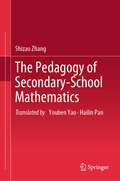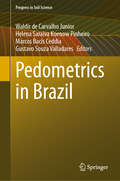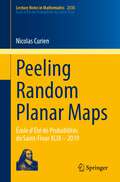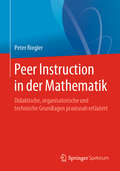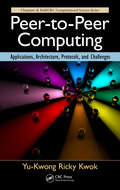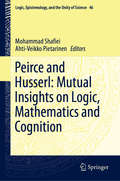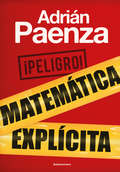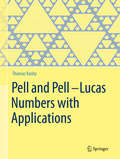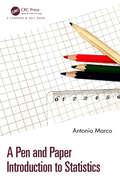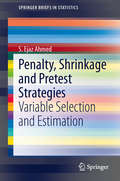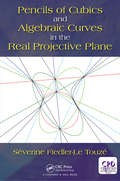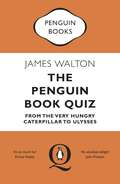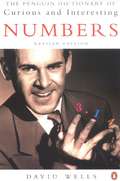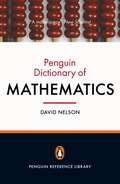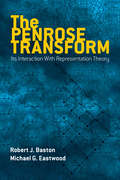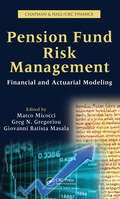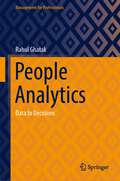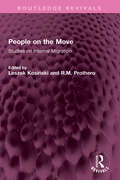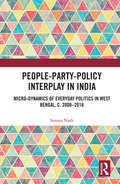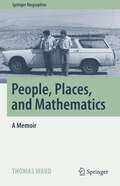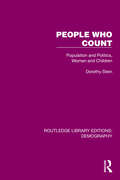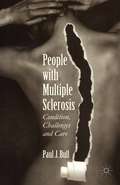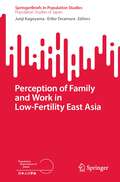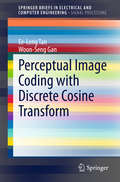- Table View
- List View
The Pedagogy of Secondary-School Mathematics
by Shizao ZhangThis book elucidates the principal aspects and characteristics of secondary school mathematics teaching and learning in China. It combines the cultivation of students' mathematical abilities with the improvement of teaching skills, and explores from both theory and practice to create mathematical pedagogy which has been widely recognized by experts in this field. This book presents a number of mathematics teaching principles and methods, and has been used as an important resource book for mathematics teachers’ education.
Pedometrics in Brazil (Progress in Soil Science)
by Waldir de Carvalho Junior Helena Saraiva Koenow Pinheiro Marcos Bacis Ceddia Gustavo Souza ValladaresIn a world expected to reach a population of almost 10 billion inhabitants by 2050 and facing rapid global warming, it is essential to develop studies to better characterize and preserve the existing environmental heritage. Among these assets, soil stands out, which is fundamental for the balance of life on the planet (air quality and composition, temperature regulation, carbon and nutrient cycling, water cycling and quality, natural "waste" (decomposition) treatment and recycling, and habitat for most living things and their food). Due its importance, Soil information is increasing recently in order to attend human demands for land use management and capability, reduce erosion risks and soil security, for example. Particularly in Brazil, advances in soil science are now required to attend the new national systematic soil survey that have as a goal soil sustainability and security. Gathering machine learning tools, pedometrics and pedological concepts is a way to achieve these demands regarding soil data and related products. This book summarizes remarkable insights from the II Pedometrics Brazil Conference providing cutting-edge information to researchers, students and professionals working with soils in tropical countries such as Brazil.
Peeling Random Planar Maps: École d’Été de Probabilités de Saint-Flour XLIX – 2019 (Lecture Notes in Mathematics #2335)
by Nicolas CurienThese Lecture Notes provide an introduction to the study of those discrete surfaces which are obtained by randomly gluing polygons along their sides in a plane. The focus is on the geometry of such random planar maps (diameter, volume growth, scaling and local limits...) as well as the behavior of statistical mechanics models on them (percolation, simple random walks, self-avoiding random walks...).A “Markovian” approach is adopted to explore these random discrete surfaces, which is then related to the analogous one-dimensional random walk processes. This technique, known as "peeling exploration" in the literature, can be seen as a generalization of the well-known coding processes for random trees (e.g. breadth first or depth first search). It is revealed that different types of Markovian explorations can yield different types of information about a surface. Based on an École d'Été de Probabilités de Saint-Flour course delivered by the author in 2019, the book is aimed at PhD students and researchers interested in graph theory, combinatorial probability and geometry. Featuring open problems and a wealth of interesting figures, it is the first book to be published on the theory of random planar maps.
Peer Instruction in der Mathematik: Didaktische, organisatorische und technische Grundlagen praxisnah erläutert
by Peter RieglerSie möchten Ihre Lehrveranstaltungen aktivierender und wirksamer gestalten? Sie möchten die Verständnisschwierigkeiten Ihrer Studierenden besser erkennen und verstehen? Sie möchten die studentische Beteiligung steigern, zum Nachdenken und Diskutieren anregen? Lernen Sie das Potenzial von Clickerfragen für die akademische Lehre kennen – damit es bei Ihren Studierenden klick macht! In diesem Buch werden die Grundlagen der interaktiv-dialogischen Lehrmethode praxisnah erläutert. Dabei werden auch häufige Fragen zu didaktischen, organisatorischen und technischen Aspekten beantwortet, etwa:Was ist die Grundidee von Peer Instruction?Wie wirksam ist Peer Instruction? Wie überzeuge ich meine Studierenden davon?Welche technischen Voraussetzungen gibt es?Wie stelle ich gute Clickerfragen?Was sollte ich sonst noch beachten?
Peer-to-Peer Computing: Applications, Architecture, Protocols, and Challenges (Chapman & Hall/CRC Computational Science)
by Yu-Kwong Ricky KwokWhile people are now using peer-to-peer (P2P) applications for various processes, such as file sharing and video streaming, many research and engineering issues still need to be tackled in order to further advance P2P technologies. Peer-to-Peer Computing: Applications, Architecture, Protocols, and Challenges provides comprehensive theoretical and p
Peirce and Husserl: Mutual Insights on Logic, Mathematics and Cognition (Logic, Epistemology, and the Unity of Science #46)
by Mohammad Shafiei Ahti-Veikko PietarinenThis volume aims to provide the elements for a systematic exploration of certain fundamental notions of Peirce and Husserl in respect with foundations of science by means of drawing a parallelism between their works. Tackling a largely understudied comparison between these two contemporary philosophers, the authors highlight the significant similarities in some of their fundamental ideas. This volume consists of eleven chapters under four parts. The first part concerns methodologies and main principles of the two philosophers. An introductory chapter outlines central historical and systematical themes arising out of the recent scholarship on Peirce and Husserl. The second part is on logic, its Chapters dedicated to the topics from Peirce’s Existential Graphs and the philosophy of notation to Husserl’s notions of pure logic and transcendental logic. The third part includes contributions on philosophy of mathematics. Chapters in the final part deal with the theory of cognition, consciousness and intentionality. The closing chapter provides an extended glossary of central terms of Peirce’s theory of phaneroscopy, explaining them from the viewpoint of the theory of cognition.
¡Peligro! Matemática explícita
by Adrián PaenzaUn verdadero festival de problemas, paradojas, dilemas e historias extraordinarias, conducido por el mejor divulgador de matemática del mundo. Cuenta Adrián que tiene la costumbre de guardar, en el bolsillo izquierdo de la camisa, papelitos con anotaciones sobre cosas que le suceden, que observa o le comentan, y que después esos apuntes se convierten en los problemas de sus libros. Es que la matemática está mucho más presente en la vida cotidiana de lo que parece, y si aprendemos a ver con un poco de curiosidad, se encuentra en todos lados. Desafíos en torno a una hamburguesa; cámaras que registran todos los movimientos de la pelota en un partido; cómo es el sorteo de las causas en los juzgados judiciales; decisiones de la inteligencia artificial; problemas sobre la verdad, la verosimilitud y la falsedad; Lennon o McCartney; Voltaire y el FMI; cómo repartir los bienes de una herencia; historias sobre bitcoins y blockchain; tatuajes increíbles; un museo muy inquietante, cómo cambiar reglas injustas y muchos más.
Pell and Pell-Lucas Numbers with Applications
by Thomas KoshyPell and Pell-Lucas numbers, like the well-known Fibonacci and Catalan numbers, continue to intrigue the mathematical world with their beauty and applicability. They offer opportunities for experimentation, exploration, conjecture, and problem-solving techniques, connecting the fields of analysis, geometry, trigonometry, and various areas of discrete mathematics, number theory, graph theory, linear algebra, and combinatorics. Pell and Pell-Lucas numbers belong to an extended Fibonacci family as a powerful tool for extracting numerous interesting properties of a vast array of number sequences. A key feature of this work is the historical flavor that is interwoven into the extensive and in-depth coverage of the subject. An interesting array of applications to combinatorics, graph theory, geometry, and intriguing mathematical puzzles is another highlight engaging the reader. The exposition is user-friendly, yet rigorous, so that a broad audience consisting of students, math teachers and instructors, computer scientists and other professionals, along with the mathematically curious will all benefit from this book. Finally, Pell and Pell-Lucas Numbers provides enjoyment and excitement while sharpening the reader's mathematical skills involving pattern recognition, proof-and-problem-solving techniques.
A Pen and Paper Introduction to Statistics
by Antonio MarcoStatistics is central in the biosciences, social sciences and other disciplines, yet many students often struggle to learn how to perform statistical tests, and to understand how and why statistical tests work. Although there are many approaches to teaching statistics, a common framework exists between them: starting with probability and distributions, then sampling from distribution and descriptive statistics and later introducing both simple and complex statistical tests, typically ending with regression analysis (linear models). This book proposes to reverse the way statistics is taught, by starting with the introduction of linear models. Today, many statisticians know that the one unifying principle of statistical tests is that most of them are instances of linear models. This teaching method has two advantages: all statistical tests in a course can be presented under the same unifying framework, simplifying things; second, linear models can be expressed as lines over squared paper, replacing any equation with a drawing. This book explains how and why statistics works without using a single equation, just lines and squares over grid paper. The reader will have the opportunity to work through the examples and compute sums of squares by just drawing and counting, and finally evaluating whether observed differences are statistically significant by using the tables provided. Intended for students, scientists and those with little prior knowledge of statistics, this book is for all with simple and clear examples, computations and drawings helping the reader to not only do statistical tests but also understand statistics.
Penalty, Shrinkage and Pretest Strategies
by S. Ejaz AhmedThe objective of this book is to compare the statistical properties of penalty and non-penalty estimation strategies for some popular models. Specifically, it considers the full model, submodel, penalty, pretest and shrinkage estimation techniques for three regression models before presenting the asymptotic properties of the non-penalty estimators and their asymptotic distributional efficiency comparisons. Further, the risk properties of the non-penalty estimators and penalty estimators are explored through a Monte Carlo simulation study. Showcasing examples based on real datasets, the book will be useful for students and applied researchers in a host of applied fields. The book's level of presentation and style make it accessible to a broad audience. It offers clear, succinct expositions of each estimation strategy. More importantly, it clearly describes how to use each estimation strategy for the problem at hand. The book is largely self-contained, as are the individual chapters, so that anyone interested in a particular topic or area of application may read only that specific chapter. The book is specially designed for graduate students who want to understand the foundations and concepts underlying penalty and non-penalty estimation and its applications. It is well-suited as a textbook for senior undergraduate and graduate courses surveying penalty and non-penalty estimation strategies, and can also be used as a reference book for a host of related subjects, including courses on meta-analysis. Professional statisticians will find this book to be a valuable reference work, since nearly all chapters are self-contained.
Pencils of Cubics and Algebraic Curves in the Real Projective Plane
by Séverine Fiedler - Le TouzéPencils of Cubics and Algebraic Curves in the Real Projective Plane thoroughly examines the combinatorial configurations of n generic points in RP². Especially how it is the data describing the mutual position of each point with respect to lines and conics passing through others. <P><P>The first section in this book answers questions such as, can one count the combinatorial configurations up to the action of the symmetric group? How are they pairwise connected via almost generic configurations? These questions are addressed using rational cubics and pencils of cubics for n = 6 and 7. The book’s second section deals with configurations of eight points in the convex position. Both the combinatorial configurations and combinatorial pencils are classified up to the action of the dihedral group D8. Finally, the third section contains plentiful applications and results around Hilbert’s sixteenth problem. <P><P>The author meticulously wrote this book based upon years of research devoted to the topic. The book is particularly useful for researchers and graduate students interested in topology, algebraic geometry and combinatorics. <P><P>Features: <li>Examines how the shape of pencils depends on the corresponding configurations of points <li>Includes topology of real algebraic curves <li>Contains numerous applications and results around Hilbert’s sixteenth problem <P><P>About the Author: <P><P>Séverine Fiedler-le Touzé has published several papers on this topic and has been invited to present at many conferences. She holds a Ph.D. from University Rennes1 and was a post-doc at the Mathematical Sciences Research Institute in Berkeley, California.
The Penguin Book Quiz: From The Very Hungry Caterpillar to Ulysses – The Perfect Gift!
by James WaltonTHE PERFECT QUIZ BOOK FOR BOOKWORMS!Which Haruki Murakami novel shares its title with a Beatles song? In Roald Dahl's Charlie and the Chocolate Factory, what is Charlie's surname? What is heavy-drinking Rachel Watson known as in the title of a 21st-century bestseller? And what do you get if you add the number of Bennet sisters in Jane Austen's Pride and Prejudice to the number of Karamazov brothers in Fyodor Dostoevsky's The Brothers Karamazov?With four hundred questions covering books from literary classics to modern bestsellers, through iconic children's books and books you say that you've read but really you haven't, The Penguin Book Quiz is as appropriate for a making you look well-read at a party as it is for a book-loving family to tuck into after Christmas dinner: it's as enjoyable to read as it is to play.Featuring the work of everyone from Antony Beevor to Zadie Smith, books from The Very Hungry Caterpillar to Ulysses, and with movie, music, television and literary references abound, this entertaining quiz tickles the fancy (and the brains) of light and heavy readers alike.Answers:- Norwegian Wood- Bucket- The Girl on the Train- Eight (five sisters, three brothers)
The Penguin Dictionary of Curious and Interesting Numbers
by David WellsWhy was the number of Hardy's taxi significant? Why does Graham's number need its own notation? How many grains of sand would fill the universe? What is the connection between the Golden Ratio and sunflowers? Why is 999 more than a distress call? All these questions and a host more are answered in this fascinating book, which has now been newly revised, with nearly 200 extra entries and some 250 additions to the original entries. From minus one and its square root, via cyclic, weird, amicable, perfect, untouchable and lucky numbers, aliquot sequences, the Cattle problem, Pascal's triangle and the Syracuse algorithm, music, magic and maps, pancakes, polyhedra and palindromes, to numbers so large that they boggle the imagination, all you ever wanted to know about numbers is here. There is even a comprehensive index for those annoying occasions when you remember the name but can't recall the number.
The Penguin Dictionary of Mathematics: Fourth edition
by Dr David NelsonThe Penguin Dictionary of Mathematics takes in all branches of pure and applied mathematics, from algebra to mechanics and from number theory to statistics. Invaluable for students at all levels, it is also a useful and versatile source book for economists, business people, engineers, technicians and scientists of all kinds who use mathematics in the course of their work.
The Penrose Transform: Its Interaction with Representation Theory
by Michael G. Eastwood Robert J. Baston"Brings to the reader a huge amount of information, well organized and condensed into less than two hundred pages." -- Mathematical ReviewsIn recent decades twistor theory has become an important focus for students of mathematical physics. Central to twistor theory is the geometrical transform known as the Penrose transform, named for its groundbreaking developer. Geared toward students of physics and mathematics, this advanced text explores the Penrose transform and presupposes no background in twistor theory and a minimal familiarity with representation theory. An introductory chapter sketches the development of the Penrose transform, followed by reviews of Lie algebras and flag manifolds, representation theory and homogeneous vector bundles, and the Weyl group and the Bott-Borel-Weil theorem. Succeeding chapters explore the Penrose transform in terms of the Bernstein-Gelfand-Gelfand resolution, followed by worked examples, constructions of unitary representations, and module structures on cohomology. The treatment concludes with a review of constructions and suggests further avenues for research.
Pensar con modelos matemáticos: Variación lineal e inversa
by Glenda Lappan Elizabeth Difanis Phillips James T. Fey Susan N. FrielNIMAC-sourced textbook
Pension Fund Risk Management: Financial and Actuarial Modeling (Chapman & Hall/CRC Finance Series)
by Marco Micocci Greg N. Gregoriou Giovanni Batista MasalaAs pension fund systems decrease and dependency ratios increase, risk management is becoming more complex in public and private pension plans. Pension Fund Risk Management: Financial and Actuarial Modeling sheds new light on the current state of pension fund risk management and provides new technical tools for addressing pension risk from an integr
People Analytics: Data to Decisions (Management for Professionals)
by Rahul GhatakThis book is an exploration of the people analytics possibility, bringing out both theoretical frameworks and detailed practical case studies from the author's experience in industry and business across both sides of the table, with an understanding of data science models and SMAC (Social, Mobile & Cloud) technologies underpinning it. It further explores and lays out a business case for why organizations need to invest behind this space and why HR functions and businesses need to embrace and adopt it. The book examines how people analytics makes a difference to business, describes stages of adoption and maturity models for its effective deployment in organizations and explores the journey from employee master data management and conversion to reporting and visualizations to dash-boarding and descriptive analytics, operational analytics to finally predictive modelling. The book provides insights on the impact of big data and social networks on HR and talent frameworks and the opportunity for HR to mine these networks with a view to culling out predictive insights for the business. It also describes in great detail the specific applications of people and talent analytics through case examples. The book discusses and makes the case for HR to be metric driven focused on business outcomes. It enumerates upon “lead” and “lag” indicators and the need to leverage relevant measurement systems. It provides an understanding of relevant statistical tools that could be deployed to mine key insights from the data to enable robust decision-making, and examines the power of “visual intelligence” and data representation that goes beyond traditional tools like Excel. This book is for HR practitioners who seek to challenge the status quo. It does so by helping them leverage a data and evidence based approach; asking the right questions and building new capabilities with a view towards leading change and driving transformation both in their domain, the wider business and the larger organization. The book is also useful for HRM students to gain a deep understanding of “people analytics” as a critical sub-domain within HR. “HR is not just about people but now also about Tech, Data and Analytics. Upgrading numerical/analytics skills in order to have greater impact on the business, is the new wave of HR, which Rahul helps address via his own rich experience.”- Gurprriet Siingh, Managing Director, Russell Reynolds Associates, Mumbai, India. “This book would help HR & Leadership Teams find a way of discarding perceptions and uncovering truth by embracing data patterns as opposed to just continuing with incremental changes to how it has always been. This is particularly so of successful organizations.”- Vikas Gupta, Divisional Chief Executive Officer, Education and Stationery Products Business, ITC Limited, Gurugram, India.
People on the Move: Studies on Internal Migration (Routledge Revivals)
by Leszek A. Kosinski R. Mansell ProtheroOriginally published in 1975, this volume examines conceptual and theoretical aspects of the study of internal migration, both in chapters dealing specifically with theory and data and in case studies. The book discusses the question of who migrates, and why and what are the patterns of flow and direction of movement. The consequences of migration are analysed. Migration is one of the most difficult components of population change to conceptualize and measure and this book considers a wide range of aspects of migration and the problems connected with it.
People-Party-Policy Interplay in India: Micro-dynamics of Everyday Politics in West Bengal, c. 2008 – 2016
by Suman NathThis book analyses the political transition in West Bengal, India, which witnessed longest democratically elected Left regime of the world. It examines and compares micro-dynamics of political practices in India and delineates underlying political themes of state politics. The author explores the politics of land reform and the anti-land-acquisition movements which were critical points in the contemporary history of Bengal in independent India. The volume further delves into the caste and communal politics which had been latent until the Left Front’s loss in the state, as well as the what sets apart politics in West Bengal from other Indian states. Based on thorough ethnographic research, this volume will be of great interest to scholars and researchers of South Asian studies, politics and political processes, sociology and social anthropology.
People, Places, and Mathematics: A Memoir (Springer Biographies)
by Thomas WardThis memoir chronicles the journey of an academic, tracing a path from primary school in Zambia to a career in higher education as a mathematician and educational leader. Set against the backdrop of the 20th century, the book explores how early influences and historical events shape an individual's life and professional trajectory. The author shares childhood experiences across three parts of Africa, providing an original perspective as a witness to the post-colonial period. Through personal reflections, the memoir delves into the emergence of ideas and collaborations in mathematics and how these shape career choices. It also offers candid observations on the major changes in British higher education since the 1980s. Intended for a general audience, this book provides a compelling read for anyone interested in the experience of becoming a mathematician, and higher education in general.
People Who Count: Population and Politics, Women and Children (Routledge Library Editions: Demography #12)
by Dorothy SteinOriginally published in 1995, this book confronts the contentious political issues on all sides of the population debate, including immigration, demographic competition, gender ratios, reproductive research and children’s rights. The book argues that lower fertility rates are preferred by women themselves; are beneficial in their own right to both women and children; and should not be used as a bargaining chip in any other area of the development debate. Drawing on a large body of research in anthropology, child psychology and population studies the book presents evidence that the poor do not necessarily have large families as form of financial security, or to put them to work; people without offspring are less lonely in old age; immigration and refugee controls in the Northern Hemisphere have been more driven by politics than rational calculation and human rights; social security does not require a large cohort of young workers. This book is a challenging contribution to the development debate. It presents a persuasive case for policies which recognise hopeful trends in relieving the environmental and social pressures of a globally increasing population.
People with Multiple Sclerosis: Condition, Challenges and Care
by Paul J. BullMultiple sclerosis is an incurable neurological disease of unknown cause with a fearful reputation for generating disability, unemployment, poverty and early death. This book critically surveys the current state of multiple sclerosis research, demonstrating the shortfall of current research undertaken on the lives of people with multiple sclerosis.
Perception of Family and Work in Low-Fertility East Asia (SpringerBriefs in Population Studies)
by Junji Kageyama Eriko TeramuraThis book is the first of its kind to incorporate subjective well-being (SWB) data to comprehensively explore perceptional factors that relate to fertility behavior in East Asia. The advantage of SWB data lies in the accessibility to rich information regarding perceptions, attitudes, and behaviors. With this advantage, the book inquires into the perceptions toward family and work and explores the attitudes that lead to low fertility in the region.To this end, first a comparative analysis with international cross-sectional data is performed and the East Asian characteristics of family and work perceptions are documented. Then, three democracies in the region are focused on—Japan, South Korea, and Taiwan—to investigate the relationships between cultural orientations, work–life balance, and fertility outcomes with panel data. In addition, East Asian results are compared with those in India, which has also been experiencing a rapid transition from a traditional society to an industrial one. The results support the idea that the friction between persistent gender-based role divisions and socioeconomic transformation in East Asia makes it difficult for women to balance family and work, prompting fertility decline to the lowest-low level in the region.
Perceptual Image Coding with Discrete Cosine Transform
by Ee-Leng Tan Woon-Seng GanThis book first introduces classic as well as recent computational models for just-noticeable-difference (JND) applications. Since the discrete cosine transform (DCT) is applied in many image and video standards (JPEG, MPEG-1/2/4, H. 261/3), the book also includes a comprehensive survey of computational models for JND that are based on DCT. The visual factors used in these computational models are reviewed in detail. Further, an extensive comparative analysis of these models using quantitative and qualitative performance criteria is presented, which compares the noise shaping performance of these models with subjective evaluation and the accuracy between the estimated JND thresholds and subjective evaluation. There are many surveys available on computational models for JND; however, these surveys seldom compare the performance of computational models that are based on DCT. The authors' survey of the computational models and their in-depth review of the visual factors used in them will help readers understand perceptual image coding based on DCT. The book also provides a comparative analysis of several perceptual image coders that are based on DCT, which are compatible with the highly popular and widely adopted JPEG standard.
